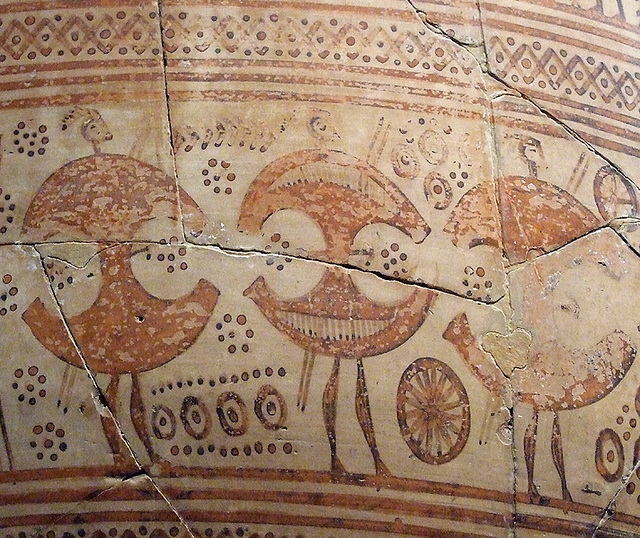Greek Geometric Terracotta Krater Attributed to th…
Detail of a Greek Geometric Terracotta Krater Attr…
Asiatic Garland Sarcophagus with Lid in the Metrop…
Asiatic Garland Sarcophagus with Lid in the Metrop…
Asiatic Garland Sarcophagus with Lid in the Metrop…
Marble Statue of a Youthful Herakles with a Little…
Marble Statue of a Youthful Herakles in the Metrop…
Marble Statue of a Youthful Herakles in the Metrop…
Marble Statue of a Youthful Herakles in the Metrop…
Detail of the Head of a Marble Statue of a Youthfu…
Detail of a Marble Statue of a Youthful Herakles i…
Marble Statue of a Girl in the Metropolitan Museum…
Marble Statue of a Girl in the Metropolitan Museum…
Detail of a Marble Statue of a Girl in the Metropo…
Geometric Terracotta Krater in the Metropolitan Mu…
Geometric Terracotta Krater in the Metropolitan Mu…
Detail from a Geometric Terracotta Krater in the M…
Detail from a Geometric Terracotta Krater in the M…
Marble Statue of a Wounded Warrior in the Metropol…
Detail of a Marble Statue of a Wounded Warrior in…
Detail of the Head of a Marble Statue of a Wounded…
Detail of a Marble Statue of a Wounded Warrior in…
Silver Handle from a Serving Dish in the Metropoli…
Greek Geometric Terracotta Krater Attributed to th…
Greek Geometric Terracotta Krater Attributed to th…
Greek Geometric Terracotta Krater Attributed to th…
Bronze Foot in the Form of a Sphinx in the Metropo…
Fragment of a Marble Greek Grave Stele of a Warrio…
Marble Statue of the Apollo Lykeios in the Metropo…
Marble Statue of the Apollo Lykeios in the Metropo…
Marble Statue of a Seated Muse in the Metropolitan…
Marble Statue of a Woman in the Metropolitan Museu…
Marble Portrait of a Man in the Metropolitan Museu…
Bronze Man & Centaur in the Metropolitan Museum of…
Marble Head of an Elderly Woman in the Metropolita…
Marble Head of an Elderly Woman in the Metropolita…
Lower Part of a Marble Statue of Hygieia in the Me…
Pair of Silver Strigels in the Metropolitan Museum…
Lower Part of a Marble Statue of Hygieia in the Me…
Lower Part of a Marble Statue of Hygieia in the Me…
Marble Portrait of an Antonine Woman in the Metrop…
Marble Statue of Herakles Seated on a Rock in the…
Marble Statue of Herakles Seated on a Rock in the…
Marble Portrait of an Antonine Woman in the Metrop…
Detail of a Sarcophagus Lid with a Reclining Coupl…
Location
See also...
Keywords
Authorizations, license
-
Visible by: Everyone -
All rights reserved
-
724 visits
Detail of a Greek Geometric Terracotta Krater Attributed to the Hirschfeld Workshop in the Metropolitan Museum of Art, July 2007


Terracotta krater, ca. 750–735 B.C.; Geometric; Geometric
Attributed to the Hirschfeld Workshop
Greek, Attic
Terracotta; H. 42 5/8 in. (108.3 cm) diameter 28 1/2 in. (72.4 cm)
Rogers Fund, 1914 (14.130.14)
During the Geometric period, monumental grave markers were introduced in the form of large vases, often decorated with funerary representations. It was only in the Archaic period that stone sculptures were used as funerary monuments. On this magnificent krater, the main scene, which occupies the widest portion of the vase, shows the deceased laid upon a bier surrounded by members of his household and, at either side, mourners. For optimal clarity, the dead man is shown on his side and the checkered shroud that would normally cover the body has been raised and regularized into a long rectangle with two projections. The zone below shows a procession of chariots and foot soldiers. The figures may refer to the military exploits of the deceased; however, as hourglass shields and chariots played a more limited role at this time than in the earlier Bronze Age, the scene more likely evokes the glorious ancestry and traditions to which the dead man belonged.
Text from: www.metmuseum.org/works_of_Art/viewOne.asp?dep=13&vie...
Attributed to the Hirschfeld Workshop
Greek, Attic
Terracotta; H. 42 5/8 in. (108.3 cm) diameter 28 1/2 in. (72.4 cm)
Rogers Fund, 1914 (14.130.14)
During the Geometric period, monumental grave markers were introduced in the form of large vases, often decorated with funerary representations. It was only in the Archaic period that stone sculptures were used as funerary monuments. On this magnificent krater, the main scene, which occupies the widest portion of the vase, shows the deceased laid upon a bier surrounded by members of his household and, at either side, mourners. For optimal clarity, the dead man is shown on his side and the checkered shroud that would normally cover the body has been raised and regularized into a long rectangle with two projections. The zone below shows a procession of chariots and foot soldiers. The figures may refer to the military exploits of the deceased; however, as hourglass shields and chariots played a more limited role at this time than in the earlier Bronze Age, the scene more likely evokes the glorious ancestry and traditions to which the dead man belonged.
Text from: www.metmuseum.org/works_of_Art/viewOne.asp?dep=13&vie...
- Keyboard shortcuts:
Jump to top
RSS feed- Latest comments - Subscribe to the comment feeds of this photo
- ipernity © 2007-2024
- Help & Contact
|
Club news
|
About ipernity
|
History |
ipernity Club & Prices |
Guide of good conduct
Donate | Group guidelines | Privacy policy | Terms of use | Statutes | In memoria -
Facebook
Twitter

Sign-in to write a comment.